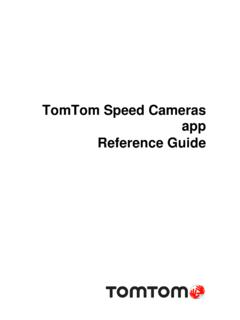Transcription of AUTOMATED SPEED ENFORCEMENT PROGRAM REPORT 2014 …
1 1 AUTOMATED SPEED ENFORCEMENT PROGRAM REPORT 2014-20172In 2013 the State Legislature and Governor Cuomo enacted Sec. 1180-b of New York State s Vehicle and Traffic Law (VTL), which granted New York City the authority to pilot an AUTOMATED SPEED ENFORCEMENT PROGRAM to deter speeding in 20 school SPEED zones. The first SPEED camera violation was issued in January 2014. In June 2014, the pilot was expanded to a total of 140 school SPEED zones, in order to support the pursuit of the City s Vision Zero goal of eliminating traffic deaths and serious injuries. This REPORT covers data from the PROGRAM from its inception through December 2017. Deterrence of speeding is the PROGRAM s sole goal.
2 The faster a vehicle is moving the harder it is for the driver of that vehicle to avoid a crash. In fact, a driver at 40 MPH needs 300 feet to perceive, react and brake to an unexpected event twice as far as a driver at 25 MPH, who only needs 150 feet. SPEED is also a critical determinant of injury severity. A pedestrian who is struck by a vehicle traveling at 30 MPH is twice as likely to be killed as a pedestrian struck by a vehicle travelling at 25 City s SPEED camera PROGRAM proves highly effective at deterring speeding. Speeding during school hours at typical fixed camera locations drops 63 percent. Despite the fact that the City is prohibited from using SPEED cameras during the majority of the year, injuries at these locations have dropped 17 percent.
3 However, 5 out of every 6 New Yorkers who are killed or severely injured are struck at times or places where the law prohibits the use of SPEED cameras to deter speeding. The camera PROGRAM will protect more New Yorkers from serious crashes if the State Legislature allows the City to run the PROGRAM according to nationally recognized best practices. Accordingly, the City supports legislation which would authorize the City to place SPEED cameras on high-crash streets near schools, increase the number of school SPEED zones at which the City can use a SPEED camera to deter speeding, and expand the number of hours at which the City can operate SPEED cameras. Executive Summary325 MPH 35 MPH 40 MPH Speeding is a Leading Cause of Fatal Traffic CrashesDeterring speeding is critical because the faster a vehicle is moving the harder it is for the driver of that vehicle to avoid a crash.
4 In fact, a driver at 40 MPH needs 300 feet to perceive, react and brake to an unexpected event twice as far as a driver at 25 MPH, who only needs 150 feet. And the faster a vehicle is moving when a crash occurs, the more damage it will cause upon impact. Even a small difference in vehicle SPEED makes a big impact in terms of safety a pedestrian who is struck by a vehicle traveling at 30 MPH is twice as likely to be killed as a pedestrian struck by a vehicle traveling at 25 MPH. Indeed, for these reasons combating excessive speeding was the leading recommendation provided by New York City residents during the Vision Zero town halls and workshops held by the New York City Department of Transportation (DOT) and New York City Police Department (NYPD) in 2014 - and is continually cited as a top concern today.
5 These facts inform the New York City s Vision Zero initiative s focus on SPEED management. The City uses a variety of approaches aside from SPEED cameras, including increased installation of SPEED bumps, focused NYPD ENFORCEMENT , signal reprogramming, reduced SPEED limits and street redesigns to combat speeding. This effort has contributed to the fact that the first four years of the Vision Zero PROGRAM are the four safest years, in terms of traffic fatalities, since the City began keeping records in SIGHT DISTANCEQUEENS BOULEVARD43rd S T. 92 60 118 129 147 153 Driver Reaction (feet)Braking Distance (feet)4 Solutions to the SPEED ProblemSPEED BUMPSS peed bumps are a raised area of a roadway, typically 3 to 4 inches, which deflects the wheels and frame of a traversing vehicle to reduce vehicle SPEED .
6 SPEED bumps are not appropriate for use on bus routes or truck routes, which limits their application on many of the City s most crash prone corridors. In 2017 the City installed 390 SPEED bumps, which is more than double the pace of installation in the years prior to Vision City uses a variety of methods to encourage people to drive at safe speeds. DOT and NYPD frequently assess the speeding conditions in neighborhoods across the City, and identify the appropriate solutions for each ENFORCEMENT of the SPEED limit deters law-breaking. Traditional speeding summonses carry significant financial penalties, along with points on the driver s operating record and significant consequences for the driver s insurance.
7 In 2017 NYPD issued over 149,000 speeding summonses, an increase of over 93 percent from the years prior to Vision Zero. SPEED LIMITSS peed limits promote road safety by establishing an upper limit on SPEED appropriate for the street s design, vehicle volume and pedestrian density. On November 7, 2014, New York City reduced the citywide default SPEED limit to 25 MPH, and has installed over 5,000 new SPEED limit signs, each with a rider alerting motorists to the use of Photo ENFORCEMENT . 160,0002017149,910 NYPD ISSUED SPEEDING SUMMONSES5 STREET DESIGNS treet design strategies which reduce speeding typically remove excess width from existing traffic lanes, or reassign traffic lanes to provide space for pedestrians, bicyclists or parking.
8 Traffic calming is a context-dependent approach to reducing excessive speeding. The City has increased the number of safety engineering projects completed in locations with high rates of severe pedestrian crashes by over 138 percent since the start of Vision TEAMSV ision Zero Street Teams are an NYPD-DOT joint on-street outreach project which works together to identify corridors with significant crash history, along with the causes of those crashes. NYPD and DOT staff then spend a week distributing tens of thousands of fliers to pedestrians and drivers with safety tips, addressing the most common causes of those serious crashes. The following week, the NYPD focuses its ENFORCEMENT resources on those traffic violations which cause serious crashes along that same corridor.
9 EDUCATIONP ublic education is a key aspect of the City s strategy to combat speeding. The City has deployed hard-hitting ads on television, radio, billboards, bus stops and elsewhere to alert aggressive drivers of the consequences of their behavior. These ads have proven effective: 72 percent of drivers recall having seen the paid media campaign, 75 percent of those drivers REPORT that the advertisements led them to expect more ENFORCEMENT of traffic laws, and 86 percent of those drivers REPORT that the ads persuaded them to pay more attention to pedestrians and cyclists while driving. Solutions to the SPEED ProblemIntervale Avenue, Bronx6 SPEED cameras are a new addition to New York State, but they are not a new technology.
10 SPEED cameras have been proven effective at reducing speeding related crashes in many jurisdictions around the world and within the United States. Over 140 communities use SPEED cameras to enforce the SPEED of SPEED CamerasStudies from Europe and Australia, which have more experience with SPEED cameras, show that these programs substantially reduce speeding violations and injury crashes. Large scale deployment of SPEED cameras are central to traffic safety programs in these nations, because SPEED management is the key to preventing serious crashes. These programs are designed to deter speeding at all hours of the day, throughout the jurisdiction. Indeed, the experience of these cities and nations is that SPEED camera systems which operate 24 hours a day, 365 days a year, and are consistently applied on all major streets, soon come to issue very few violations while also preventing speeding and SPEED related crashes.



















